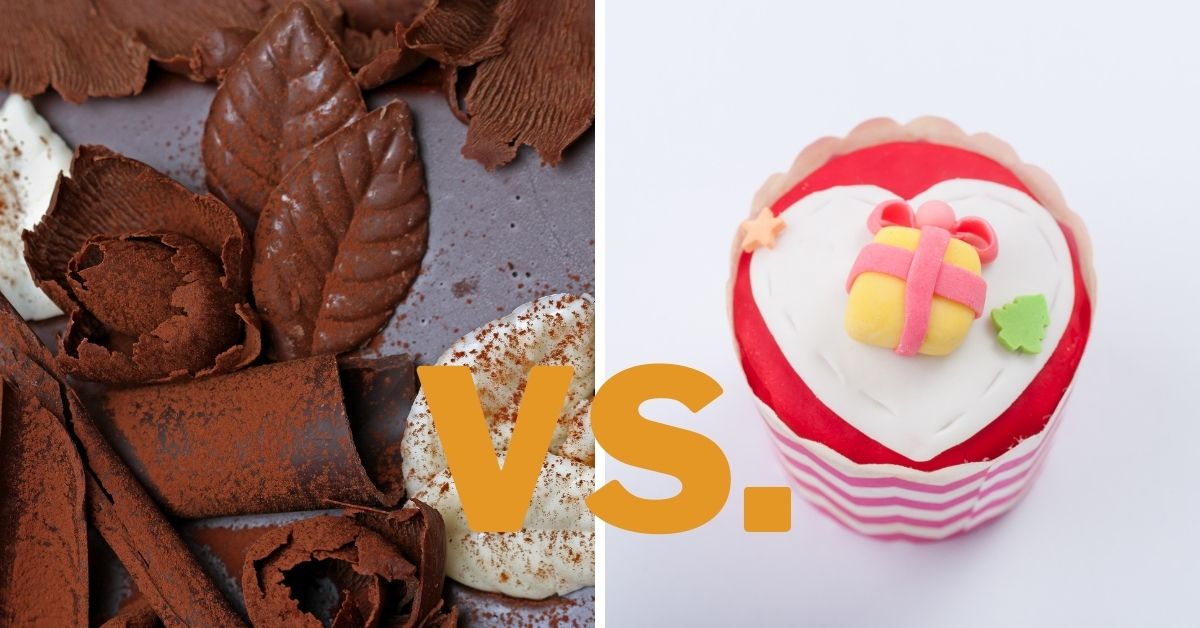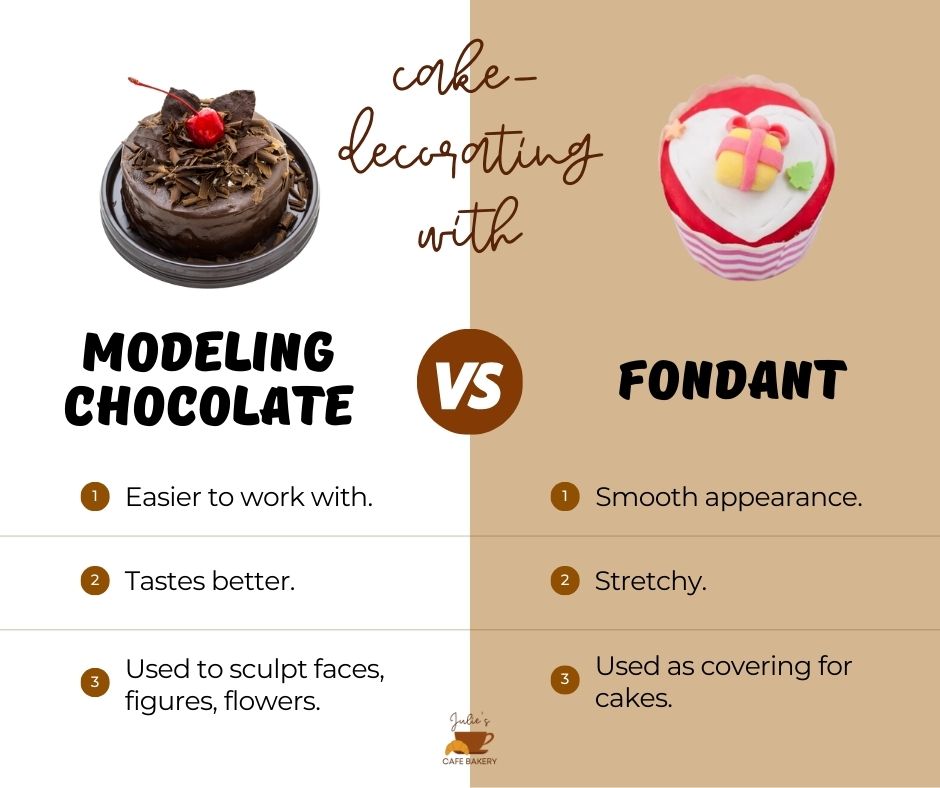Modeling Chocolate or Fondant: Which To Use for Cake-Decorating?

Modeling chocolate and fondant are some of the most popular materials for creating cute cake decorations. At first glance, modeling chocolate and fondant appear to be very similar. But the two cake-decorating mediums are different. So, let’s look at what distinguishes the two.
Modeling chocolate is easier to work with and tastes better than fondant. Modeling chocolate is versatile and is used to cover cakes or sculpt realistic faces, model figures, and flower decorations. Similarly, fondant is a great cake topper; but it doesn’t create fine elaborate decoration details.
Modeling chocolate and fondant are huge contenders in the world of cake decoration. But what exactly are each of these two confectionery concoctions? Here’s a detailed primer!
Differences between modeling chocolate and fondant
Modeling chocolate, also known as chocolate or candy clay, is made by melting chocolate (semi-sweet, dark, white, or milk) and adding corn syrup or simple syrup. The mixture is then kneaded to achieve a stiff, pliable consistency. The little water in the syrup seizes the chocolate turning it into a soft clay that can be worked and molded in different shapes or draped over cakes.
While you can use modeling chocolate to cover cakes, they’re well-known for creating more elaborate decorations, figurines, and models for cakes. You can shape it, iron out the seams, and it will hold the details perfectly. In addition, it allows you to mold various shapes that may not easily be possible with the softer fondant.
On the other hand, fondant is a pliable, dough-like icing popularly used to decorate cakes. It’s made of water, sugar, food-grade glycerin, and gelatin. The gelatin gives fondant elasticity and flexibility, which makes it easy to work with. However, it requires an additional stabilizing boost since it’s stretchy (which can be excellent for morphing around cake corners but not great for modeling).
Typically, fondants have a smooth appearance and hence are used as covering for cakes as they offer clean, pleasant, and crisp covers. However, you can only use them to make small figurines and models to decorate cakes as they cannot be rolled out thinly without tearing.

Does modeling chocolate crack?
Modeling chocolate is less likely to dry or crack. However, if you stir too much when melting the chocolate, the modeling chocolate will break and leach out liquid fat.
Does fondant crack?
Fondant tends to dry out and crack if it’s rolled too thick or thin and can be challenging to stick pieces together. If you’ve just covered a cake with fondant and you notice a crack or tear, you can use your finger to rub solid vegetable shortening around the rip in circular motions to fix it.
Which one to use, modeling chocolate or fondant?
Modeling chocolate can be blended, molded, worked, and shaped in more refined details and depth than fondant. When it cools, modeling chocolate remains the same and doesn’t melt or turn into a less desirable shape.
The warmth of your hand can soften the modeling chocolate, enabling you to make different decorations and shapes. Moreover, since it doesn’t harden fast, modeling chocolate is ideal when you need more time to design an elaborate decoration. However, this property can cause it to melt quickly in scorching weather.
Conversely, when making simple models, choose fondants as they’re easy to work with. However, when using fondant, you’ll need to apply a sticky surface such as buttercream to the cake before applying the fondant, so it takes hold. Besides, the fondant dough can become too soft, making it difficult to stay in specific patterns or shapes.
Can you mix fondant and modeling chocolate?
While individually modeling chocolate and fondant are slightly different, they work well when blended. That’s because you get the benefits of using the softer, more pliable fondant and the sturdiness of the modeling chocolate, making your decorations hold up well. For the very best results, use a 50/50 combination of the two decoration mediums.
How to harden modeling chocolate?
Once you’ve decorated the cake, you’ll need the modeling chocolate to harden so it holds its form. Typically, modeling chocolate hardens when exposed to air, but how quickly it sets depends on the air temperature and humidity.
It will take longer to harden in humid environments, and sometimes it can even take two days to harden depending on the thickness. So, it would be ideal if you work in a cool, dry environment or use a dehumidifier or air conditioner to manage the humidity and temperature of the room you’re working in.
Alternatively, you could add CMC (Carboxymethyl Cellulose) powder to your modeling chocolate since it can thicken and strengthen it. CMC also helps the modeling chocolate harden more quickly.
Note that you shouldn’t put a modeling chocolate decorated cake in the fridge or freezer as it will attract moisture. When you take it out, it’ll melt, becoming goopy and lose the clean, sleek look.
Is modeling chocolate good for eating?
Since it’s made of melted chocolate and syrup, modeling chocolate is edible. However, edible, in this case, doesn’t necessarily mean palatable or tasty.
